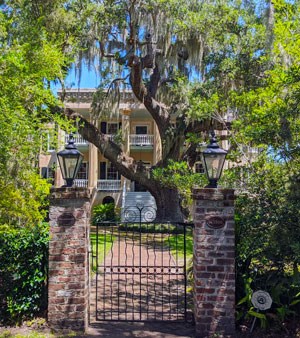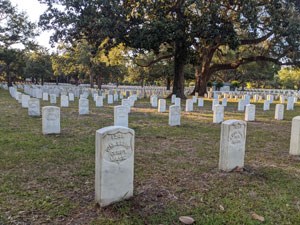Last updated: April 10, 2024
Article
“Sad Evidences of Bravery and Patriotism…” - The 54th Massachusetts in Beaufort, South Carolina
The arrival of the 54th Massachusetts Infantry in Beaufort County, South Carolina was welcomed on June 4, 1863 by a combination of natural beauty and unpleasant living conditions in the Lowcountry landscape. A majority of the men in the regiment had never witnessed such a scene as they did along the Carolina coast, although it was a sight they would become all too familiar with over the next two years. The regiment’s camp changed throughout the area over the following weeks, however, Beaufort County would remain a base of operations.
Their reception upon arrival in Beaufort bore many similarities to their grand departure from Boston just days before. Among those waiting to greet the 54th as well as its Colonel, Robert G. Shaw, was Thomas W. Higginson - a former member of abolitionist John Brown’s “Secret Six” who had recruited and trained a regiment of African American troops at Camp Saxton along the Beaufort River. On June 6, The New South described the regiment’s debarking: “The 54th attracted very general attention by their soldierly bearing, as they marched through the streets of Beaufort, which were never before trod by as many free-born colored people, since the ancestors of the chivalry founded it. We shall look in upon the new regiment, and give our impressions of it, at some future day.”1 The paper’s review of the regiment would come much sooner than expected by most.

NPS Photo
Toward Land’s End on St. Helena Island, the 54th camped within clear view of Hilton Head, just across the Port Royal Sound. It was from this point, on July 4, that the regiment marched toward the Brick Baptist Church - built in 1855 by enslaved people of the island, the church eventually was used as a house of education for those connected to its construction. On this particular Independence Day, the regiment celebrated at the Church along with teachers and scholars from Penn School, which included a reading of the Declaration of Independence and a group of young students singing “My Country Tis of Thee.” As mentioned in a letter by Colonel Shaw, “Today there has been a great meeting for the coloured people at the Baptist Church 6 or 7 miles from camp. I rode down there… Can you imagine anything more wonderful than a coloured abolitionist meeting on a South Carolina plantation? Here were collected all the freed slaves on this Island listening to the most ultra abolition speeches…while two years ago, their masters were still here, the lords of the soil and of them. Now they all own a little themselves, go to school, to church, and work for wages… Such things oblige a man to believe that God isn’t very far off."2
Soon after, on July 16, Shaw’s regiment fought for the recently celebrated ideals of freedom on James Island in Charleston Harbor - this would come to be known as their true baptism of fire. The engagement was followed shortly after by an attack on Morris Island’s Fort Wagner, which was led by the 54th Massachusetts on on July 18. Of the regiment’s approximate 650 men who joined the assault, 272 were listed as casualties. Eventually Colonel Shaw would be recorded among the dead, as news circulated that the young Bostonian was buried on the Morris Island beach along with his men. This action and undaunted bravery, however, helped to solidify the belief among many, that African American troops were a force to be reckoned with. As mentioned later by the regimental surgeon, Dr. Lincoln Stone, “I really think they showed themselves very brave, true soldiers, in both of the engagements they have been in…” and in the regiment’s action they have “gone far to remove whatever prejudice ay have existed in this department against colored troops.”3

NPS Photo
Toward the evening of Sunday July 19, those wounded in the engagement at Fort Wagner began to arrive along the shores of Beaufort. During the Federal occupation of the town, many of the homes of former planters became not only centers of operation for the army, but also sixteen hospitals - in the aftermath of Fort Wagner, nearly every available bed would be required. As the troop transports arrived, a runner was sent down Beaufort’s New Street to warn those at Hospital No. 6, otherwise known as “The Castle,” to prepare for the coming procession. The Free South reported on the men of the 54th again just a few days later, “Sunday last was a sad day in Beaufort. The arrival of the Cosmopolitan with the wounded from Morris Island, bringing also intelligence that our brave troops had been repulsed in the assault upon Fort Wagner, cast a gloom upon the community… As the vessel neared the wharf with its freight of suffering, a silent, mournful concourse gathered around the landing, eager to lend a helping hand in removing the wounded to the hospital. As those who were able to walk filed off the boat and wended their slow way through the crowd, the scene was truly pathetic… The wounded of the 54th Massachusetts came off the boat first, and as these sad evidences of the bravery and patriotism of the colored man passed through the lines of spectators every heart seemed to be touched, and we will vouch for it that no word of scorn or contempt for negro soldiers will ever be heard from any who witnessed the sight…”4

NPS Photo
Although many of the enlisted men of the 54th were initially taken to Hospital No. 6, they would, over time, be seen at other hospitals around town, including Hospital No. 11, and officers at Hospital No. 5. Among the men taken to Hospital No. 6 was Medal of Honor recipient Sergeant William Carney, who had had sustained five different wounds at Fort Wagner while saving the regimental flag from capture. His condition was described by Penn School teacher Charlotte Forten, who mentioned that the Sergeant suffered “great pain, being badly wounded in the leg.” Forten, just as well as the likes of Clara Barton and Harriet Tubman, was present to assist in mending the wounds of those who had recently arrived from the battlefield. Though the regiment had been badly mangled at Fort Wagner, the men retained a light air about Hospital No. 6, or as described by The Free South, “in a most cheerful condition for men who are such sufferers…” and continued …”They look with impatience for the day of release; when they can again meet the enemy.”5
Written by Park Ranger Rich Condon, Reconstruction Era National Historical Park
1“Arrival of the 54th Massachusetts Regiment." The Free South (Port Royal, SC), 6 June, 1863, p. 3
2Robert Gould Shaw Letters to His Family and Other Papers (MS Am 1910). Houghton Library, Harvard University. https://id.lib.harvard.edu/ead/hou00649/catalog Accessed July 20, 2020
3Chapter Five: Battery Wagner. Thunder at the Gates: the Black Civil War Regiments That Redeemed America, by Douglas R. Egerton, Basic Books, 2016, p. 144.
4 The Free South (Port Royal, SC), 25 July, 1863, p. 2.
5 The Negro Hospital Under Dr. Durand. The Free South (Port Royal, SC), 25 July, 1863, p. 2.
